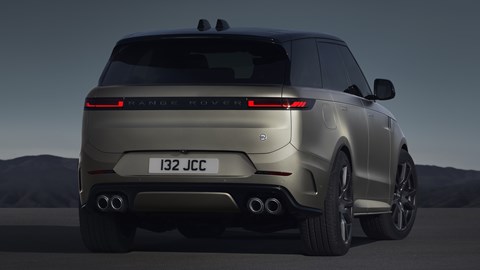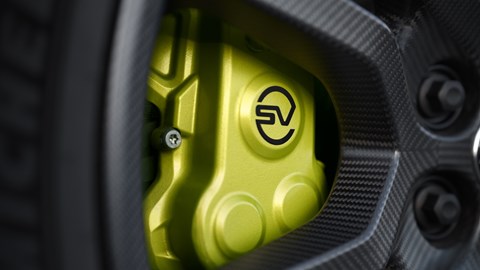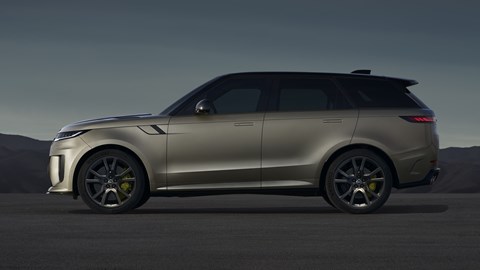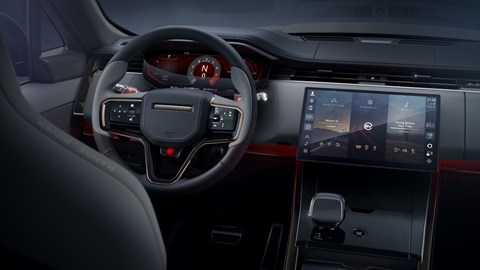► The most hardcore Range Rover yet
► 4.4-litre twin-turbo V8 replaces old supercharged 5.0
► Initial run of cars all allocated
This is the fastest, highest-performing, most hardcore and most fiendishly clever SUV to come out of Jaguar Land Rover’s Special Vehicle Operations division yet. It’s the new Range Rover Sport SV, a successor to the old Sport SVR and the result of throwing quite a lot of very smart and slightly mad people at a new Range Rover Sport and a big pile of money.
Changes over the core Range Rover Sport are incredibly extensive – this is the most thorough project SVO’s tackled since the Jaguar XE Project 8 – and include several world firsts, all aimed at giving this SUV a frankly insane breadth of ability.
The kicker? Even if you want one, even if you have the money, you can’t have one. Yet. The initial run of Edition One cars (550 of which are coming to the UK) are available exclusively by invitation. They represent the first year of production, so the rest of us plebs will only be able to place an order sometime in 2024.
So what’s been changed?
Let’s start with the exterior and visual changes. The starting point is of course, the current Range Rover Sport – the smaller, ostensibly sportier sibling to the full-sized Range Rover, it’s based on the same platform and shares the same minimalist design language. SVO has resisted the urge to chav it up too much but there are a few obvious changes over the core car.

First, there’s a lower bodykit with a black tideline running the whole way round the bottom of the car to ‘ground’ it. There’s a unique satin bronze colour, utilising less gloss than ever for a more matte finish – it’s nice in the flesh, and decidedly un-flashy.
More eye-catching is the sheer volume of carbon-fibre on show. The bonnet’s entirely carbon, though it’s exposed only on the upper air intakes. There’s carbon all round the bodykit, and slightly aftermarket-looking carbon badges. These are all available in either glossy or satin finish.
The biggest lumps are the wheels. At 23-inches, they’re the largest fully carbon wheels in the world, and save a remarkable 36.5kg of unsprung mass. The carbon pattern’s expertly matched to meet up in the centre of each pair of spokes, which looks ace, though we’d hate to see the bill if one encountered an errant kerb.
Behind them sit optional carbon-ceramic brakes, saving a further 34kg and providing the sort of stopping power one needs in a 2.5-ton SUV. It’s the first time Land Rover’s used carbon-ceramics, and these ones use unique eight-piston calipers developed by Brembo for this car.

The rear track’s widened for a bit of extra stance and to accommodate massive, 305-section rear tyres – which, while they may be Pilot Sport all-seasons, Land Rover say offer more grip than the previous SVR’s summer tyres.
What about under the skin?
That’s even more extensive. The powertrain isn’t really the big deal here, though. Sure, it’s a 4.4-litre V8, but being twin-turbocharged rather than super does feel rather less special. Still, it’s a sign of SVO having to move with the times, and it apparently offers a 15% improvement in mpg and CO2 emissions.
And it’s not as if that’s at the expense of power. 626bhp and 553lb ft correspond to a top speed of 180mph and 0-62mph in just 3.6 seconds. That’s about 60bhp and 37lb ft more than the old 5.0, and so it’s almost a second quicker to 62.
Mild hybrid tech is only really here for CO2 reduction – it’ll be standard on all V8 Range Rovers from the next model year.
It’s the suspension where things get really clever. As usual for a Range Rover, there’s height-adjustable air suspension on all four corners. The SV sits 15mm lower than the standard car in all its modes but still raises up enough for some serious off-roading if really necessary.

But debuted on this car is a new system called 6D dynamics – essentially, hydraulically interlinked dampers that do away with the need for anti-roll bars and also provide pitch control. The old car had a tendency to squat under acceleration and nosedive under braking, but SVO reckons they’ve got this nixed.
Added to all-wheel steering, a locking rear differential and torque vectoring via braking, there’s an awful lot going on underneath the Range Rover Sport SV – all in the pursuit of making a 2.5-ton SUV drive like a sports car.
SVO’s also fitted Range Rover’s fastest ever steering rack and rear-biased the four-wheel drive. The result is that it’ll pull a claimed 1.1 lateral g while cornering on all-season tyres, in the most aggressive ‘SV’ driving mode. Also available are Comfort, Dynamic and a slew of off-road driving modes.
What’s new inside?
Immediate offerings are new sports seats swathed optionally in leather-free woven fabrics – they feel pretty good. The front seatbacks are fitted with yet more carbon fibre, and face a rear bench shaped into two discrete sports seats of its own. Often the rear bench of a sporty model is left well alone, so this is a nice touch.
You’ll also find illuminated gearshift paddles that light up red in SV mode, and a ceramic gear selector.
The biggest-ticket item inside are the new ‘Body and Soul Seats’ (BASS, conveniently). These have been developed with Canadian audio specialists Subpac and incorporate transducers in the seat backs to compliment the sound system with targeted, high-fidelity vibrations.

Initially it feels rather like you’re sat on top of a subwoofer with the bass turned up, but after a few minutes the nuances become clearer. The system doesn’t just enhance bass for the sake of it, but through the sensitivity of the occupant’s skin and the conductivity of their skeleton (honest) low frequencies become more audible without having to increase the volume.
We found it genuinely seemed to increase the immersiveness of the music being played, though we’re less convinced by the inbuilt ‘Wellness’ programs that claim to ‘enhance front-seat occupants’ mental and physiological wellbeing by influencing heart rate variability’. We imagine that the six pre-selected Wellness tracks will be played once each before you head back to your own tunes, whether George Gershwin or Limp Bizkit.
When can I have one and how much?
Not yet and a lot. As mentioned, the first year’s production has already been allocated to a curated bunch of customers. Land Rover’s keen to discourage ‘flippers’ buying desirable cars and selling them immediately for a huge profit, so it’s likely the buyers have been chosen to minimise this. So don’t expect to see too many available in the classifieds either. Those lucky people have paid at least £171,460 for the privilege.
Land Rover hasn’t announced pricing for when it deigns to let the serfs purchase one, but we reckon you’ll need at least £160k – and expect to spend a lot more than that if you want the full package with carbon everything and the clever seats. For those not counting, that’s about double the entry price for a standard Range Rover.